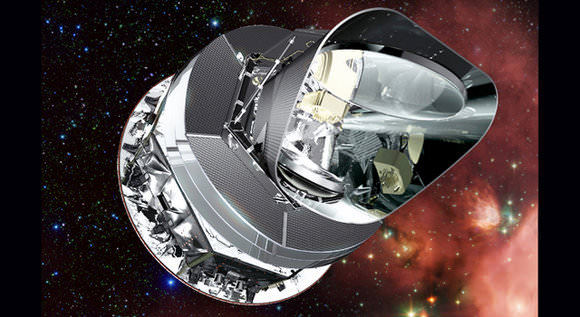[/caption]
As of August 13, 2009, the Planck mission is officially in business. It is now seeing light billions of years old, left over from the Big Bang. From its location in the L2 point, the spacecraft started collecting science data as part of the “First Light Survey” which is intended to check out all the systems. If all goes as planned, these observations will be the first of 15 or more months of data gathered from two full-sky scans.
Researcher Chris North wrote on the Planck website that “the major science results will take quite a while to come out due to the immense amount of computation needed to analyse them, and are expected in around 3 years’ time. These results will be a full-sky map of the Cosmic Microwave Background, and more accurate measurements of the parameters which have governed how our Universe has evolved.”
The mission, which is led by the European Space Agency with important participation from NASA, will help answer the most fundamental of questions: How did space itself pop into existence and expand to become the universe we live in today? The answer is hidden in ancient light, called the cosmic microwave background, which has traveled more than 13 billion years to reach us. Planck will measure tiny variations in this light with the best precision to date.
After the 15 month prime mission, Planck will continue to scan the sky until its coolant runs out.
For more on Planck, check out these websites:
Cardiff University’s Planck website
ESA’s Planck Website
NASA’s Planck website
Planck Blog


Yayyyyyy!!
I love the CMB.
I’ll 2nd that.
In three years we will hopefully know for sure if there is inflation, and much more about its physics. I’ll bet it’s one of the simpler models, but you never know…
To anyone who has an idea about this:
Is there any sort of similarity between inflation and the present expansion acceleration?
I did a Wien calculation and got that a 2.7 kelvin black body would have a peak at a 7.8 mm wavelength. If so, what does the coolant cool? Anyway, I say yaaa, also.
A cool cooperation between ESA and NASA, We can all be proud. I suspect the data will be a surprise.
“I suspect the data will be a surprise.”
It’d be funny if Planck uncovered an exceedingly subtle pattern that, when decoded, said “Hello there, sentient beings. This is God. Yep, turns out I was real all along.”
Nexus,
Or it might turn out to be a label saying something like “Experiment X4589TYO” with a list of values corresponding to the universal constants.
Nah, ‘Drink Coke’, that’s what it will find.
“It’d be funny if Planck uncovered an exceedingly subtle pattern that, when decoded, said “Hello there, sentient beings. This is God. Yep, turns out I was real all along.””
Or just a massive picture of a middle finger pointed back at the universe.
Astrofiend:
You mean like this?
IVAN3MAN Says:
August 17th, 2009 at 9:52 am
🙂 Precisely.
I’m telling you man, we’re in some sort of lab. Our whole universe is probably one of many universes being created in some hadron collider. It’s the only thing that makes sense!
@ ND:
Careful there, ND, you might start behaving like Elwood Ralson. 😉